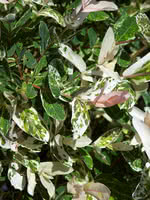Mon-Fri 9am - 5pm Mountain time
Common Hackberry vs Dappled Willow
Celtis occidentalis
Salix integra Hakuro-Nishiki
NOT AVAILABLE THIS SEASON - MIGHT RETURN
The Common Hackberry is a medium-sized deciduous tree that resembles the American Elm but is immune to Dutch Elm Disease. They are versatile and can adapt to a variety of growing conditions.
It produces purple-red, berry-like fruit with a large seed in the center. Both the sweet flesh, which tastes similar to dates, and the crunchy seed are edible. The fruit remains on the tree throughout the winter, offering a valuable food source for birds and other wildlife.
The Common Hackberry can also be a great addition to a pollinator garden. The tree itself is a host for the larvae of several butterfly species and the flowers provide a source of pollen and nectar.
Dappled Willow is a small, cold hardy shrub with unusual beauty. Its leaves are pink in spring, maturing into variegated shades of pink, white and green. After losing their leaves in autumn, the stems maintain a rich red color throughout the winter. For a splash of color, try Dappled Willow on its own or as a hedge.

